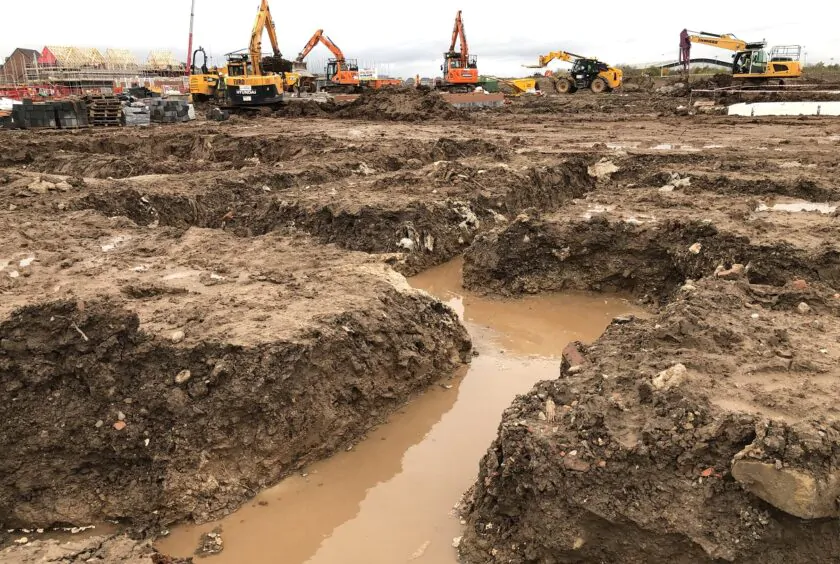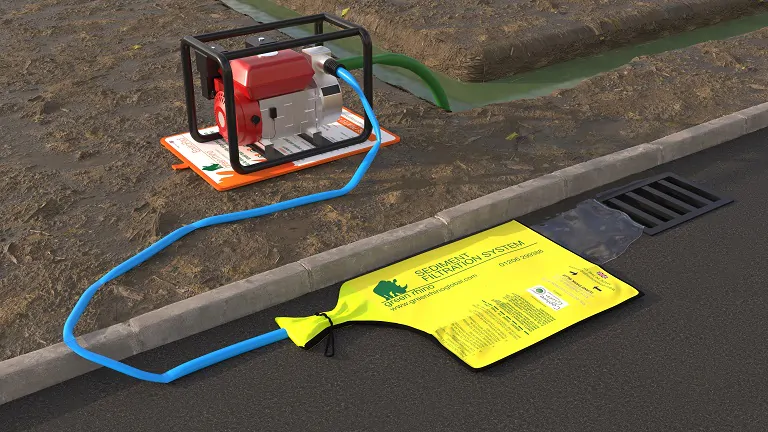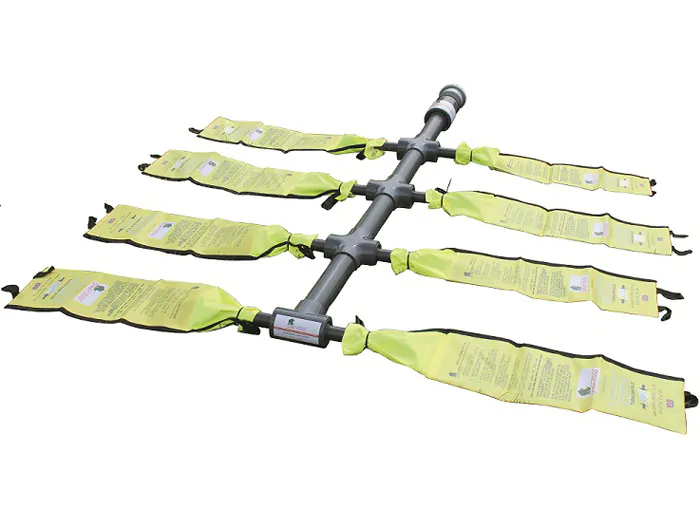Best Practice for Pollution Prevention Part 3: Dewatering

Part 2 of our Best Practice Guide to Pollution Prevention talked about silt-laden water and how to prevent it contaminating and blocking roadside drains. In this section, we talk about the best way to pump water out of excavations (dewatering) and discharge it into the environment without breaking the law.
Flawed Dewatering
In Spring 2022, a leading UK housebuilding company was fined £433,000 for multiple water pollution offences. These all involved the illegal discharge of muddy water into a nearby river.
A common source of silt-laden water comes from pumping out flooded excavations. This may be pumped onto site roads where it can enter surface water drains or it might be discharged directly into natural waterways.
Environment managers are well aware of the legislation around dewatering so why are shortcuts taken?
Contractors are under pressure to get the job done. Faced with an unexpected dewatering job, they might have to wait for a settlement tank to be ordered and delivered or, if the water is contaminated with hydrocarbons or other pollutants, a vacuum tanker. Both of these approaches are expensive too.
So, faced with delays and expensive call-out or rental charges, a contractor might be inclined to turn a blind eye to the pollution risk. The key is to provide tools that enable the job to be done quickly, easily and at low-cost. An additional factor here is education. Silt is not an obvious contaminant and site workers may be unaware of its potentially damaging effects.
Best Practice Dewatering
Fortunately, if you are well-prepared you can dewater most small to medium-sized excavations in a way that is fast, affordable and compliant with environmental regulations.

Best practice is to pump the water through a sediment filter (sediment sock or silt bag). This will filter out silt so you can discharge the cleaned water direct to surface water drains or a natural waterway.
Beware poor quality sediment filters, however, which can easily burst under pressure. Site workers often don’t need too many excuses to abandon what they may see as unnecessary hassle. Providing cheap, ineffective silt bags gives them just such an excuse.
Green Rhino’s range of rugged Sediment Filters are built to survive the rigours of repeated use on construction sites and roadside works. With options for hydrocarbon capture and ultra-fine sediment filtration on sensitive sites, you can make sure your workers have the right tools for every sediment dewatering scenario. Green Rhino Sediment Filters are standard issue for the UK’s leading utility maintenance contractors who dig a lot of holes.
For many high-volume dewatering jobs the only recourse is to use settlement tanks. But some jobs fall in between and here Green Rhino has come up with a low-cost solution that helps you dewater higher volumes quickly, safely and with a huge cost saving.
Working with a UK construction customer, we developed the Green Rhino Manifold which can harness up to eight sediment filters simultaneously. This can deliver the throughput and filtration capacity of a settlement tank. Stored on site, the Manifold can be mobilised in around ten minutes and filters can be emptied and refitted if they get full. Filtered sediment can be added to a spoil heap and reused on site. Compared to the hire costs of a settlement tank, the Manifold will pay for itself in weeks.

In many cases you will need a dewatering permit to discharge water into the environment. In all cases, contact your local environment agency for advice. It is against the law to be operating without a permit when you need one. For more tips, read our comprehensive Best Practice Guide to Dewatering Excavations.
The Buck Stops With You
By implementing best practice pollution prevention you can minimise the risk of fines, prosecution, unplanned delays and clean-up costs. It’s likely that across your projects you have a variety of approaches being taken – some best practice, others not. Environment teams need to be stronger at demanding that the highest standards are adopted and maintained on all sites.
If you are a primary contractor you’ll have a number of subcontractors working for you but this is no excuse for allowing bad practice to be carried out. You have the power to demand that your subcontractors follow best practice. The most effective approach we’ve seen is a top 5 housebuilder which issues its subcontractors with a handbook of approved SHEQ products that must be used.
An effective approach to pollution prevention also needs buy-in from site workers. Ill-thought out approaches encourage non-compliant behaviour. The cleaner, easier to use and more durable the solutions you ask your site workers to use, the more likely they are to accept them in the first place and keep using them. Take the first step towards environmental best practice and request an onsite demonstration and toolbox talk from Green Rhino today. Invite us to present to the whole Environment team or on individual project sites.
Download the full Best Practice guide here.
